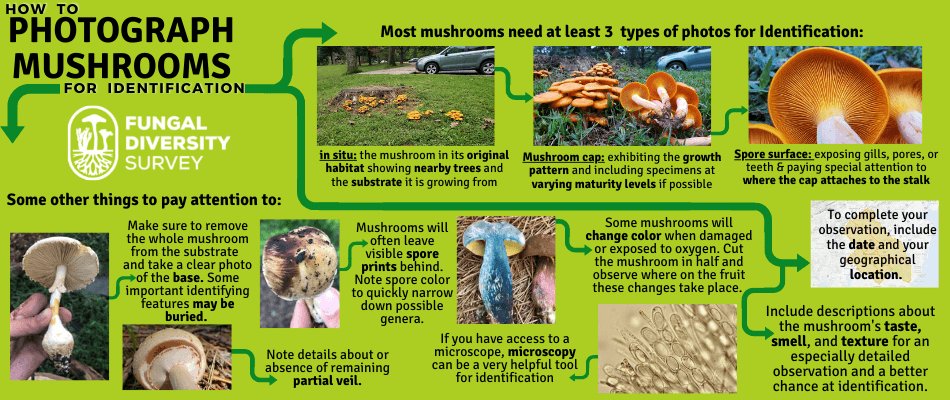Photograph

How to Photograph a Mushroom (1 min; by Sigrid Jakob)
Before You Head Out
Must-haves
- A basket, (waxed) paper bags and/or a tackle box to keep fungi separated and in good condition
- A smartphone with a camera, or a compact or DSLR camera
- Smartphone cameras automatically add GPS coordinates to images (valuable location information). They also allow for direct upload to iNaturalist, vs doing it at home.
- Compact or DSLR cameras offer higher image quality. Some cameras have GPS and macro capabilities, like the Olympus TG-6 (Tough Series), a favorite among mycophiles.
Nice to have
- Hand lens/loupe
- Large knife and/or trowel (for digging mushrooms out of soil or wood)
- Small utility or pocket knife
- Field notebook (waterproof paper and pen are best)
- Numbered FunDiS field data slips with ruler markings (in a Ziploc bag in case it rains)
- Numbered collection labels (if field data slips are not used)
- Small ruler with metric markings (if ruled field data slips are not used or for large fungi)
In the Field
Photography: Minimum required
Photos not meeting these minimal standards risk not being identified.
- Clear, in-focus picture(s)
- Fungus sporing body is large in the frame
- Fungus features (see Photo Tips in our July 2019 eNewsletter)
- Show cap, pore/gill surface, stem
- If applicable show bulb/volva, staining, discoloration
- An item like a knife or ruler or field data slip for scale
- The host or substrate should also be visible.
- This can be accomplished with one shot with specimens that show the above, plus environmental cues, such as leaves, needles or grass; or with several shots
- If smell or taste are noteworthy this should be added in the Notes section
For more phtotography and collection tips, see this page.
An iNaturalist Introduction to Mushrooming (2017, 6:13 min)
Christian Schwarz offers pointers on how to find and document mushrooms using iNaturalist.
New To Mushroom Hunting? Start Here! (30 min)
Adam Haritan from Learn Your Land
At Home
Edit, organize and upload your images
- Select your best shots (minimum of 3 - more is better).
- Crop images if needed; the specimen should fill a significant portion of the image.
- For uploading instructions see Post on iNaturalist or Post on Mushroom Observer.


